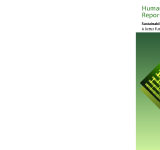The 2011 Human Development Report argues that the urgent global challenges of sustainability and equity must be addressed together – and identifies policies on the national and global level that could spur mutually reinforcing progress towards these interlinked goals. Past Reports have shown that living standards in most countries have been rising - and converging - for several decades now. Yet the 2011 Report projects a disturbing reversal of those trends if environmental deterioration and social inequalities continue to intensify;; with the least developed countries diverging downwards from global patterns of progress by 2050. The Report shows further how the world's most disadvantaged people suffer the most from environmental degradation;; including in their immediate personal environment;; and disproportionately lack political power;; making it all the harder for the world community to reach agreement on needed global policy changes. The Report also outlines great potential for positive synergies in the quest for greater equality and sustainability;; especially at the national level. The Report further emphasizes the human right to a healthy environment;; the importance of integrating social equity into environmental policies;; and the critical importance of public participation and official accountability. The 2011 Report concludes with a call for bold new approaches to global development financing and environmental controls;; arguing that these measures are both essential and feasible.
technology
The 21st century is witnessing a profound shift in global dynamics;; driven by the fast-rising new powers of the developing world. China has overtaken Japan as the world's second biggest economy;; lifting hundreds of millions of people out of poverty in the process. India is reshaping its future with new entrepreneurial creativity and social policy innovation. Brazil is raising its living standards by expanding international relationships and antipoverty programmes that are emulated worldwide. But the “Rise of the South” is a much larger phenomenon. Indonesia;; Mexico;; South Africa;; Thailand;; Turkey and other developing countries are becoming leading actors on the world stage. The 2013 Human Development Report identifies more than 40 developing countries that have done better than expected in human development in recent decades;; with their progress accelerating markedly over the past 10 years.
This report is the result of the long;; tedious and creative work of many Jordanian experts who together have reflected the most comprehensive outlook about climate change in the Jordanian context and outlined Jordan’s efforts in addressing the phenomena and the impacts of climate change. Whether in greenhouse gas inventory;; adaptation and mitigation options the readers of this report will find answers about Jordan’s minor contribution in emissions and major vulnerability to climate change impacts
Jordan faces potential serious impacts on its natural ecosystems;; on its river basins and watersheds;; on biodiversity—then cascading to impacts on food productivity;; water resources;; human health;; public infrastructure;; and human settlements. Climate change will have serious implications on the country’s efforts to eradicate poverty and realize sustainable development for current and future generations— ultimately making climate change an issue of intergenerational equity. Climate change scenarios indicate that Jordan and the Middle East could suffer from reduced agricultural productivity and water availability among other negative impacts. At the same time;; a substantial potential for cost-effective reduction of GHG emissions exists in Jordan. The Policy will provide an overarching (umbrella/high level) guidance for the Government of Jordan to implement the major climate change objectives of national priority related to adaptation and mitigation of GHG emissions
هذا التقرير يرصد الانجازات التي حققها الأردن فيما يتعلق بمتابعة منهاج عمل بيجن خلال الفترة (4004-2009);; ومتابعة وتقييم سير البرامج والمشاريع التي تطبقها اللجنة الوطنية الأردنية لشؤون المرأة الأردنية;; ودراسة الصعوبات والمشاكل التي تواجه تنفيذ البرامج المختلفة;; والعمل على ايجاد الحلول الناجعة لها. وكانت المنهجية المتبعة معتمدة على مراجعة للأدبيات السابية ومراجعة للتشريعات;; اضافة إلى الاعتماد على نتائج المسوحات والاحصاءات الصادرة والمنشورة من قبل دائرة الاحصاءات العامة;; وذلك الى جانب بناء استمارة لحصر البيانات والمعلومات المتعلقة بالمرأة والنوع الاجتماعي في القطااع الرسمي. وكانت ابرز المواضيع المطروحة في التقرير: المرأة;; الفقر;; الصحة;; العنف;; الاقتصاد;; الاعلام;; البيئة;; الطفلة الأنثى;; الحقوق;; حقوق المراة;; والنزاعات المسلحة.
تهدف هذه الدراسة الى تسليط الضوء على أهم الخصائص الديموغرافية والاجتماعية والاقتصادية للنساء اللواتي يرأسن أسرهن. وكانت ابرز المواضيع التي تطرقت اليها الدراسة: التركيب العمري;; الحالة الزواجية;; حجم الأسرة;; التعليم;; الالتحاق بقوة العمل والبطالة;; دخل وانفاق الأسرة. واعتمدت الدراسة على البرمجية الاحصائية للعلوم الاجتماعية SPSS;; وبصورة اساسية الأدوات الاحصائية الوصفية المتمثلة في الجداول والأرقام المطلقة والنسب المئوية والاشكال البيانية الملائمة. حيث تم استخلاص البيانات المتوفرة في دائرة الاحصاءات العامة ومن ثم تم تحليلها وتفسيرها. وكما قدمت الدراسة عدة اجراءات ضرورية نحو تخفيض اعباء المرأة التي ترأس أسرة من خلال تنظيم برامج تأهيلية وتدريبية للمرأة والعمل على تبسيط الاجراءات القانونية التي تعني بالمرأة ربة الأسرة وتوعيتها بها;; والاستمرار باجراء الدراسات والمسوحات للتعرف على واقع هذه الفئة.





